
Northern Cardinal male
One of the most beloved and recognizable of all songbirds, Northern Cardinals delight us with their beauty and rich whistles. They’ve been designated the state bird by seven states, more than any other bird. Many sports teams have taken their name, though tipping the scales at just 1.5 ounces (43 g), cardinals couldn’t budge a baseball or football; they might have trouble even manipulating a ping-pong ball.

Northern Cardinal male
Cardinals are non-migratory and spend the winter with their most recent offspring and neighboring cardinals in loose, fluid flocks. In late winter, some male cardinals leave their winter flock to claim a territory; soon their past mate or a new one will join them. On their breeding territory, males chase off other males and females chase off other females; neither helps its partner expel an intruder of the opposite sex. Singing is often enough to keep other cardinals from intruding on an established territory; displays and chases occur more frequently on a new territory that two different birds both want.
Cardinals sometimes fight, in the air or on the ground, grappling with feet and striking with beaks. Tussles last a few seconds. Like robins, some cardinals wage battle at our windows, the conflict escalating as the image reflects back their aggressive attitude. The best solution is to cover the window from the outside, at least where the bird sees itself.
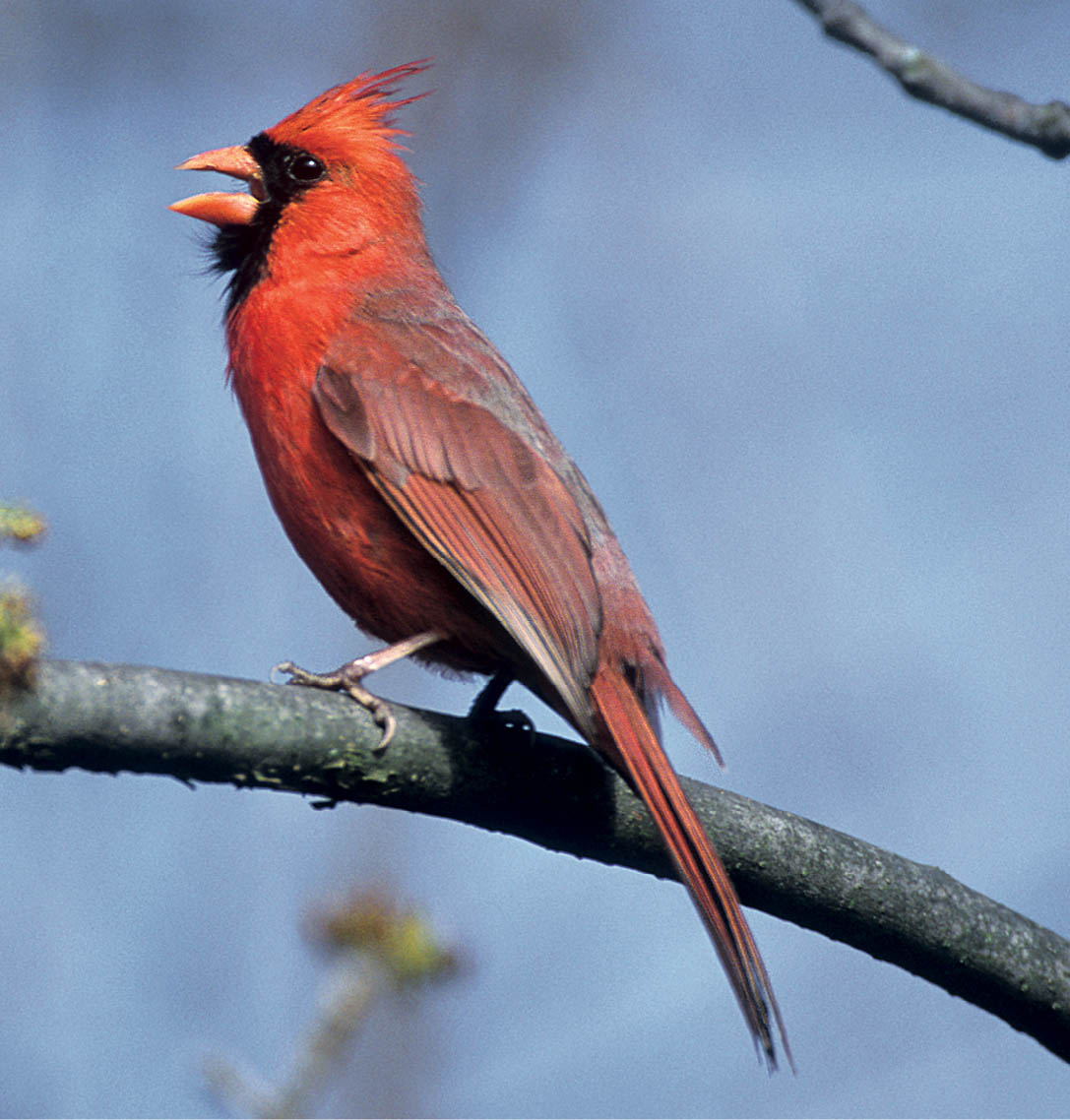
A Northern Cardinal male sings. Male cardinals are among the first birds to start singing each year, beginning in late winter. The song is a loud series of clear whistles, sweeping upward or downward. Some songs have two parts, often speeding up and ending in a slow trill. They sound like cheer, cheer, cheer or birdie, birdie, birdie.

The female Northern Cardinal is one of just a few female North American songbirds that sing. The pair sings back and forth while touring potential nest sites. Later in the nesting cycle, the female may sing while incubating, possibly telling the male when to bring her food.

A territorial Northern Cardinal attacks his reflection in a house window. Both male and female do this, most often in early spring when aggressively defending their territory against intruders, real and imagined. Once nesting starts and their aggression hormones subside, the behavior usually stops.
Once a pair has been on territory and shrubs are greening up, nest-building begins. In a charmingly simple ritual, the two examine the nest site: she fluffs her feathers and turns, he follows, and both birds call and manipulate nesting materials with their bills. They may try many sites over a period of two weeks before she selects one and starts building a nest.
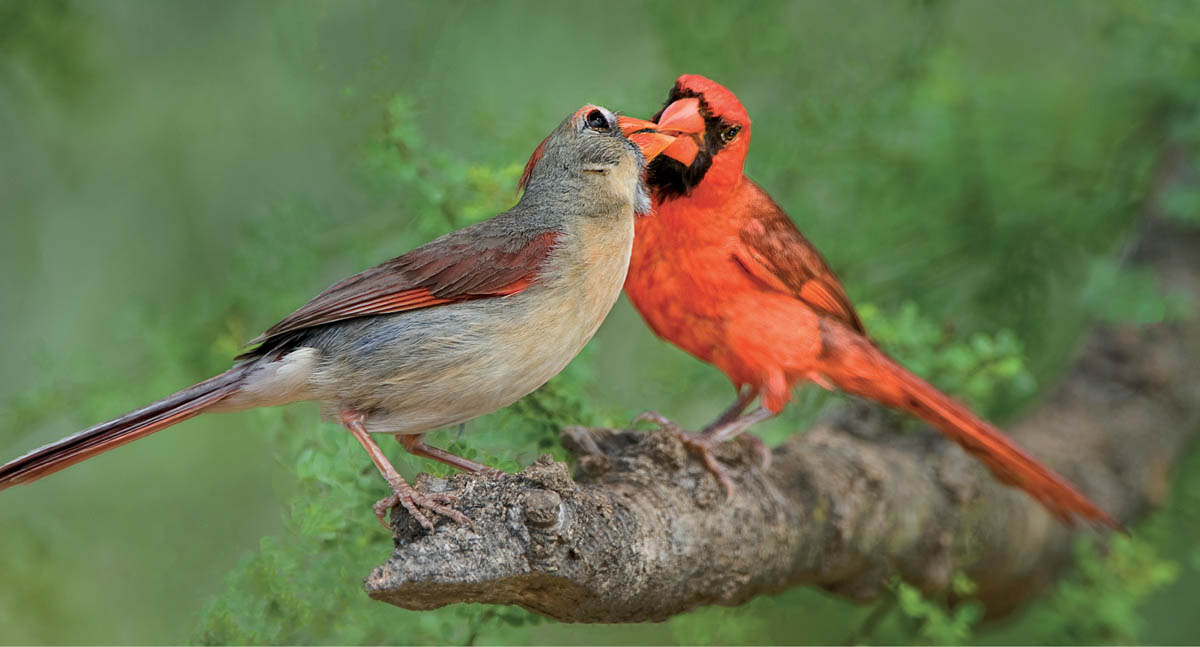
A courting male Northern Cardinal feeds his mate. Some pairs stay together through the winter, either on their breeding territory or in flocks. As the nesting season approaches, the male performs courtship displays and feeds the female, a pair-bonding behavior that becomes more frequent as she prepares to lay eggs.

A Northern Cardinal nest is usually 1 to 15 feet up, wedged in the fork of a bush, sapling, or shrub such as dogwood or honeysuckle, a conifer, or in a tangle of vines or thorny plants such as wild grape, blackberry bramble, or rose bushes. The male and female examine nest sites together, singing back and forth, but she does most of the building.
The female does the building; the male contributes nesting materials and feeds her as she works. She uses her thick, powerful bill to crush twigs, bending them around her body to shape them, and forms the cup with her body and feet. She normally completes construction in three to nine days, but during spells of bad weather may take two to three weeks. The nests are sturdy and don’t fall apart readily. Cardinals use each nest for one brood only, but one study suggested that empty nests remaining on a territory deter predation.
The female starts laying eggs within eight days of completing the nest, sometimes the very next day. She begins incubating the day she lays her last egg, though she may sleep on the nest before that. She alone has a brood patch. The male sometimes sits on the nest, but his role may be to guard the eggs rather than to keep them warm. He brings food to the female while she’s both on and off the nest.
Unlike most songbirds, both male and female cardinals sing. Females often sing on the nest, which may help males know when to bring them food. Mated pairs share many song phrases: female songs may be slightly longer and more complex than those of males, especially when on the nest.
Cowbirds parasitize a very high proportion of cardinal nests. In one study spanning several years in southern Ontario, 71 to 100 percent of nests checked between April 30 and July 2 had cowbird eggs or nestlings in them.
Incubation lasts 11 to 13 days. A bump appears on the shell before the egg is pipped. It usually takes over 12 hours for an egg to hatch after pipping, but in one case, it took only 20 minutes from the first break in the shell for the chick to emerge and the female to carry off the shell. Usually all the eggs in a clutch hatch on the same day.
Newly hatched nestlings’ eyes are closed, but they can hold up their heads and open their mouths soon after hatching. They are very still when being brooded or when the parents are away from the nest, but instantly stretch up and gape if the nest is disturbed. By eight days old, they are alert and can be frightened off the nest. If undisturbed, they usually fledge when nine or ten days old, but sometimes not until thirteen days old.
Research has found a significant relationship between plumage color and parental care. Males with bright breast plumage and females with brightly colored underwings bring a greater proportion of food for their nestlings than duller-colored cardinals. The brighter the color on both males and females, the more often they feed their young.
Lady in waiting. A male feeds an incubating female on the nest. She incubates for 11 to 13 days, while he brings her food. Sometimes she sings from the nest, which may coordinate his feeding visits. He keeps feeding her while she broods the nestlings; she transfers food to the young.

Hungry foursome. A few days old, four Northern Cardinal nestlings beg, showing their red gapes edged with whitish yellow. Notice the little arrow-like protrusions on the back of the tongue, which help direct food down the throat. Their skin is a translucent yellow.
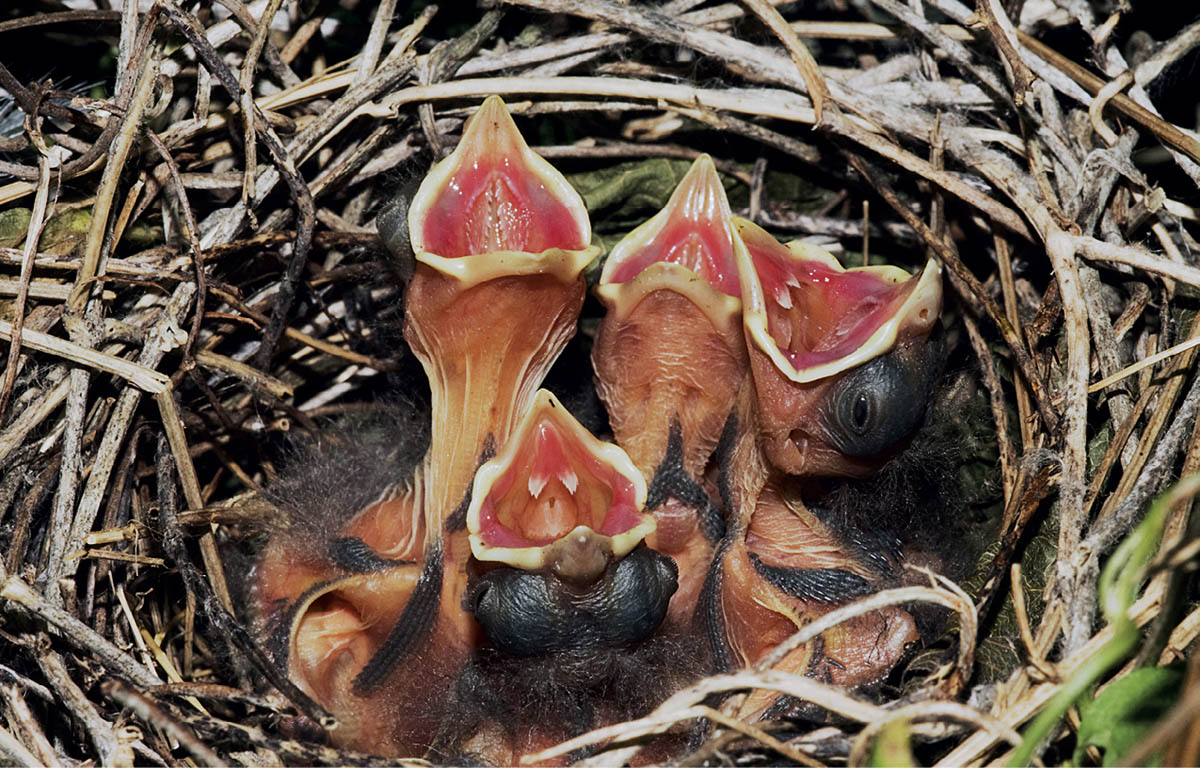
Housekeeping. A male cardinal picks up a fecal sac. Both parents remove fecal sacs, females more often than males. At first, the adults eat the sacs (which contain useful nutrients that newborn digestive systems cannot absorb). After about 5 days, the adults carry the sacs away from the nest and drop them.
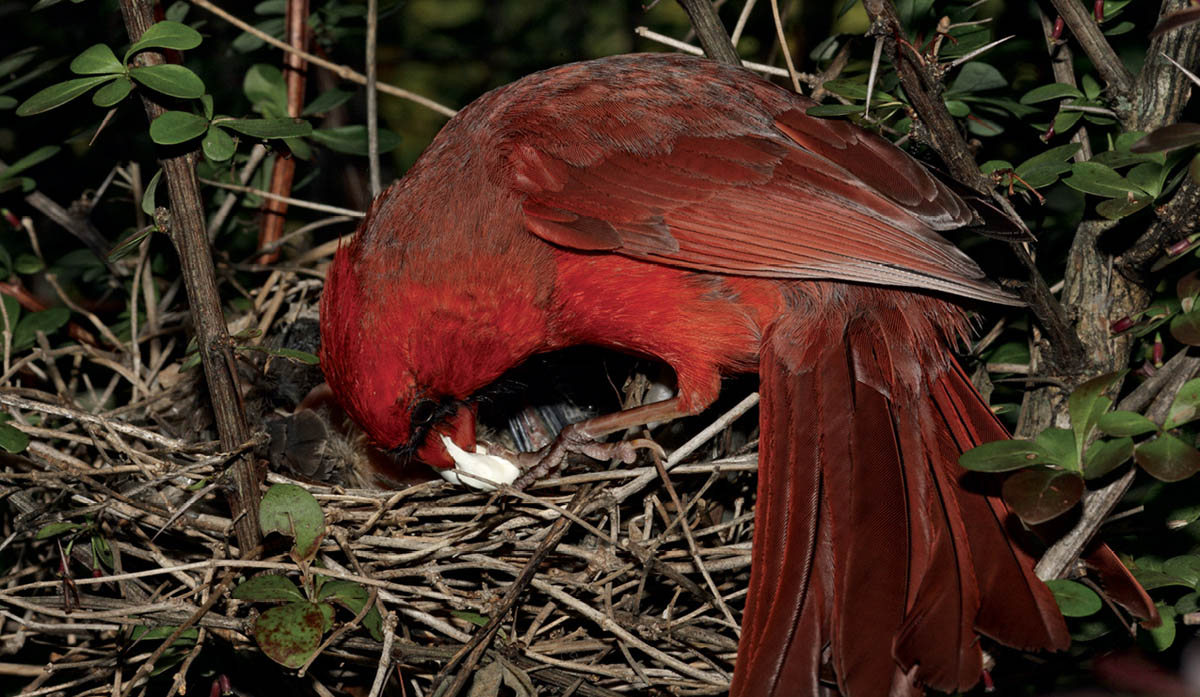
Growing up. A female Northern Cardinal brings a green caterpillar to feed one of three begging nestlings. The nestlings are fed mostly insects, including beetles, caterpillars, grasshoppers, and cicadas, with small amounts of seeds and other plant food.
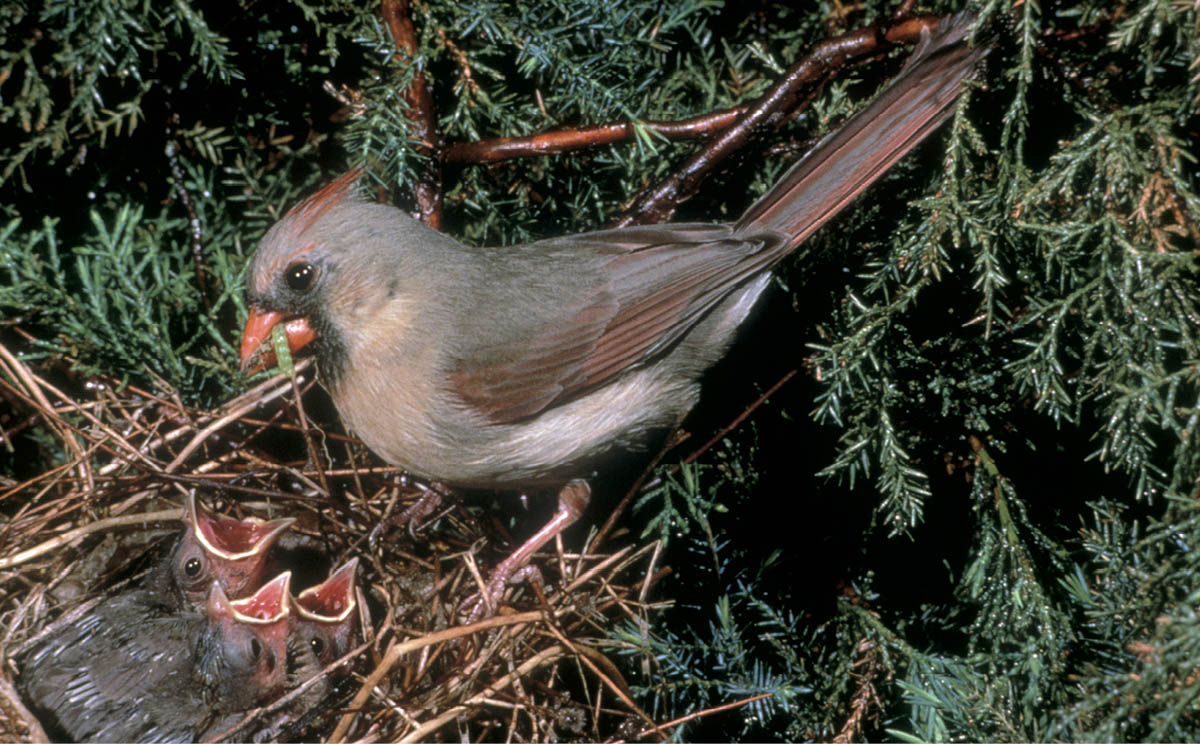
Newly fledged. This fledgling has a small crest, very short wings, and almost no tail. The adults may encourage chicks to fledge by tempting them with food or by making chip calls. The fledglings can fly only short distances at first, and for the first week, they rarely move from the branches where they first fledged. Their parents feed them up to eight times an hour.
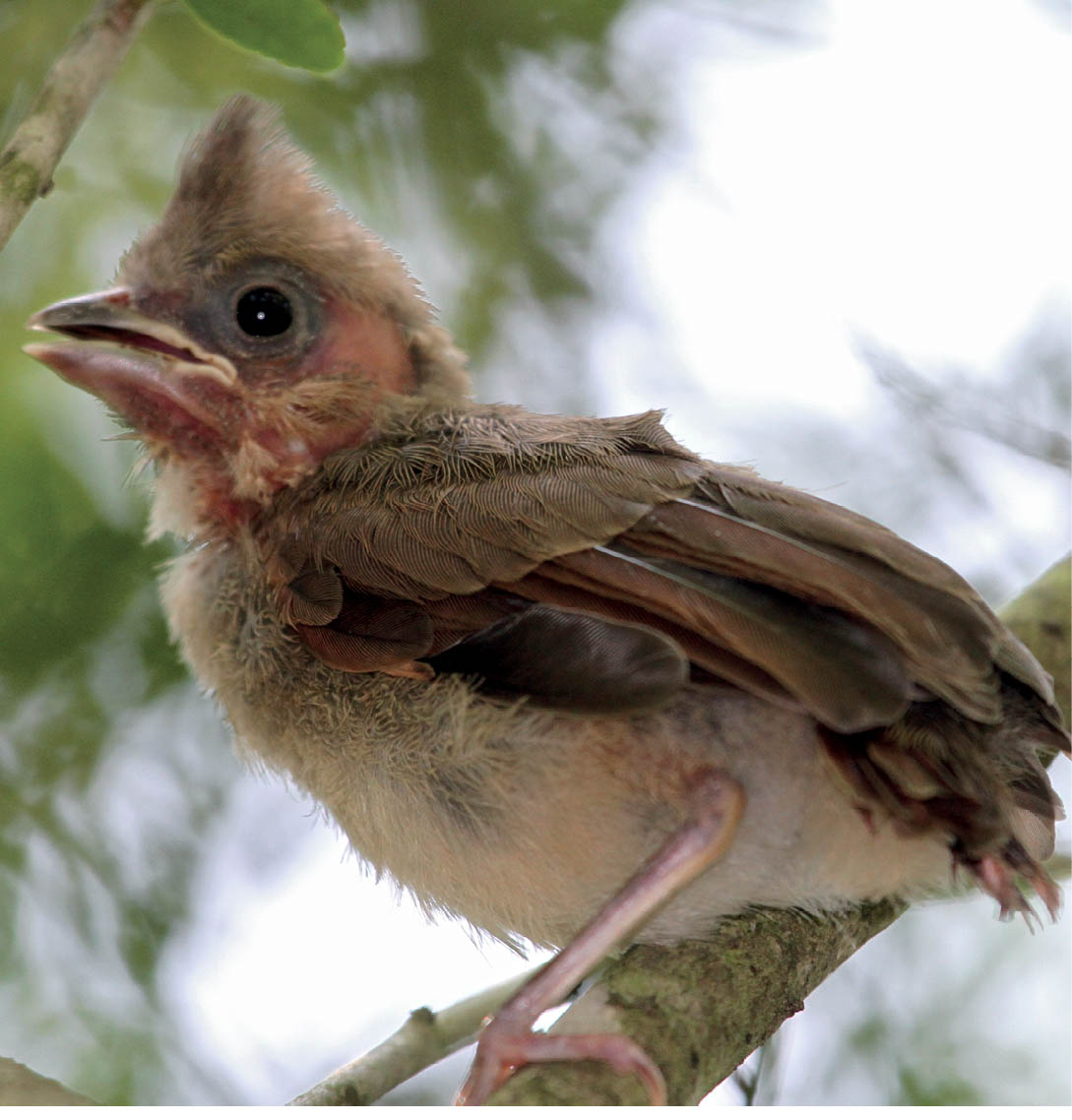
Newly fledged cardinals are extremely vulnerable to cats. If they don’t fledge prematurely, they can fly short distances, but they aren’t strong fliers for a few days more.
Both parents feed them for 10 days or so after they’ve fledged. After that, if there are one or two fledglings, the male feeds them on his own while the female starts a new nest. If there are more, she remains with them longer before starting a new nest. Cardinals may produce eggs in as many as six nests in a single season, but most of these are replacements after predation or nest destruction.

A Northern Cardinal male feeds one of two fledglings more than two weeks after they left the nest. Broods raised late in the season receive food longer than those fledging earlier in the summer.
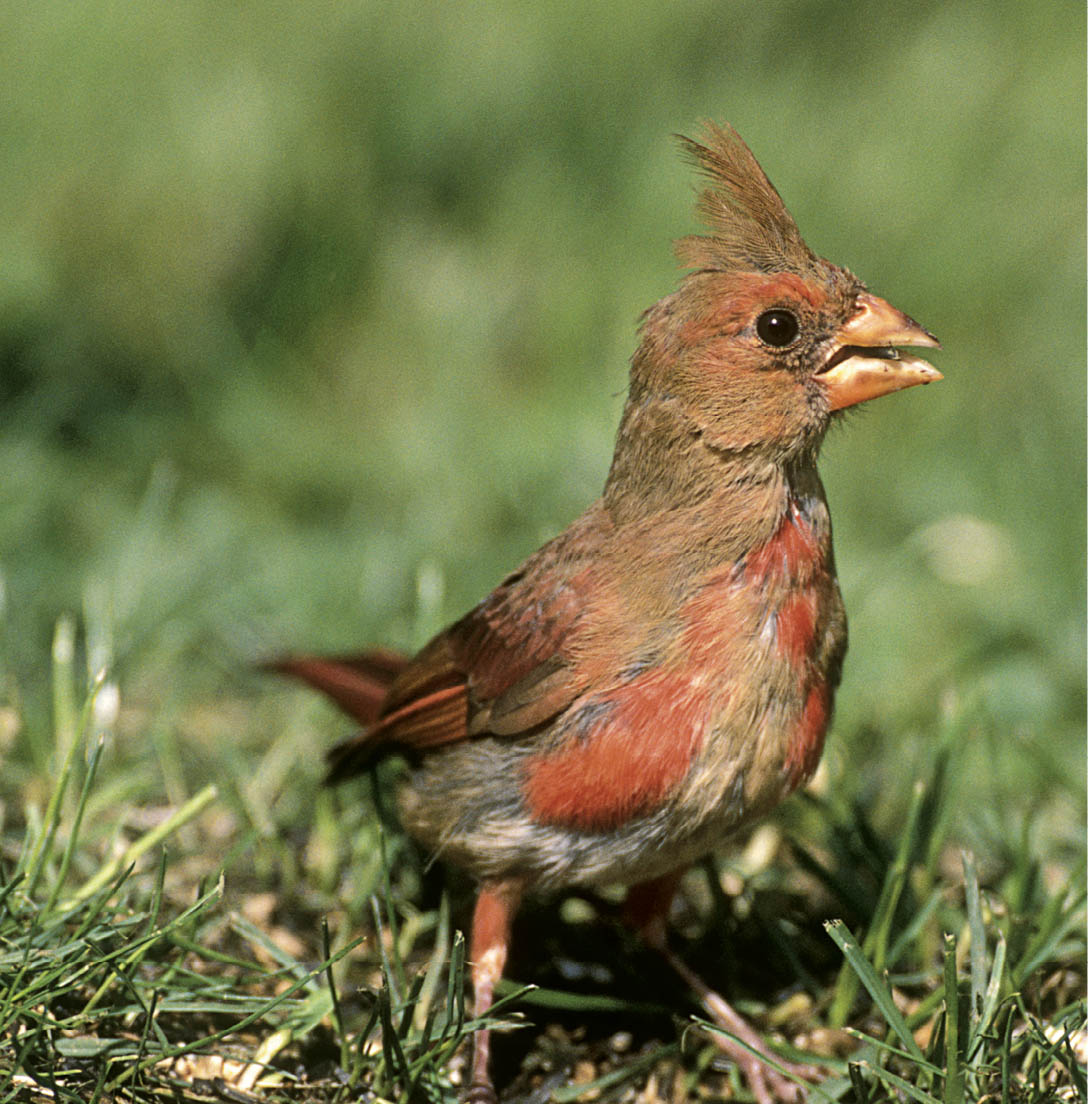
A male juvenile cardinal, molting into adult plumage, resembles an adult female except for browner wing feathers. Juvenile males often have some red on breast and flanks. The bill will be orange by winter.